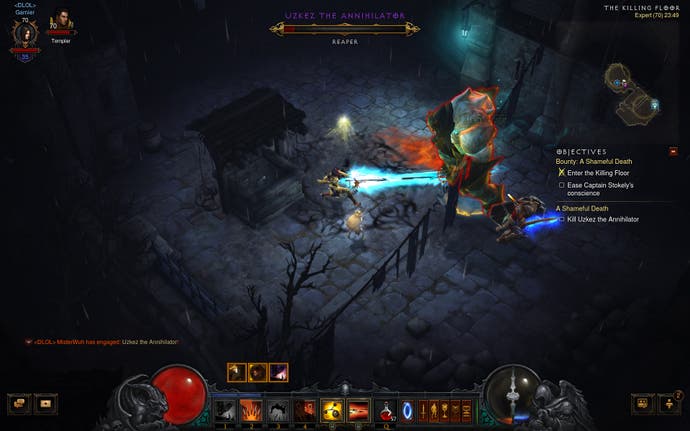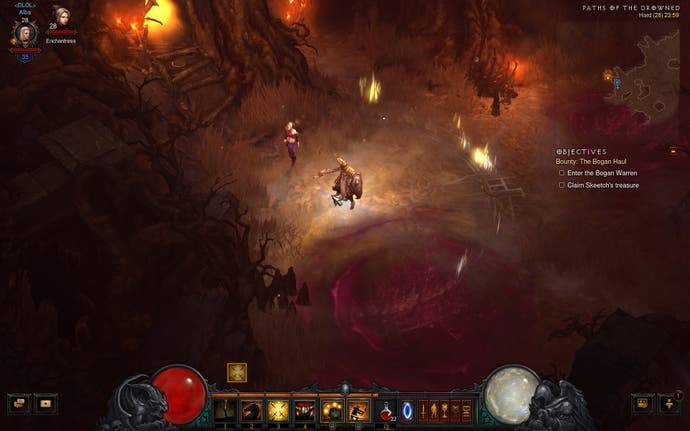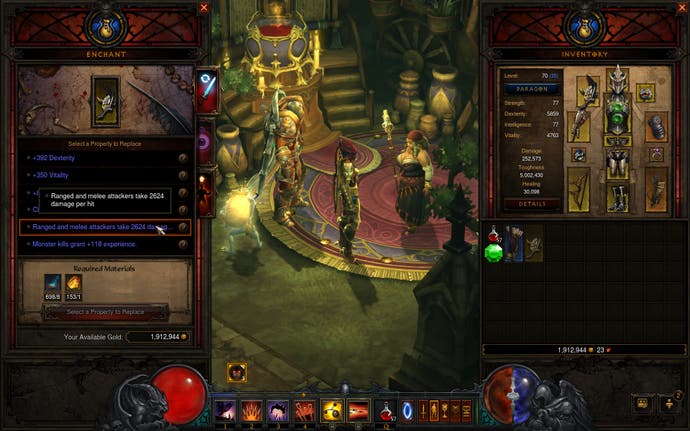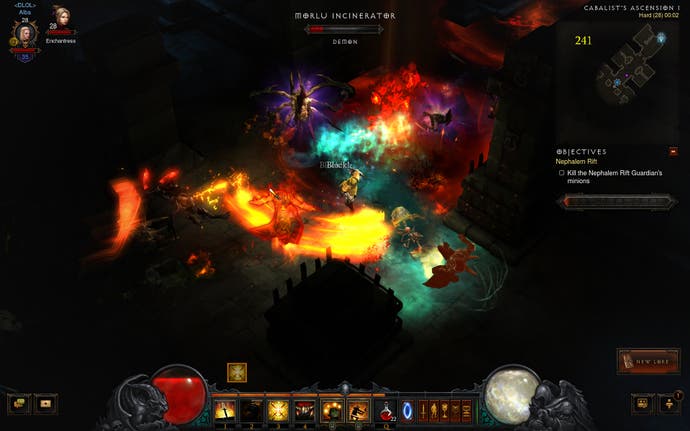Diablo 3: Reaper of Souls review
"Do you want MORE?"
With the exception of Firaxis, there's no-one left that makes expansion packs like Blizzard. In an age of bite-sized downloadable add-ons, their premium price tags raise eyebrows, even with the generous supply of new content - but that content is usually less than half the story. In these expansions, the new ideas and hard graft that have been poured into the renewal, rebalancing and restructuring of the original game usually exceeds what goes into your average blockbuster sequel.
So Blizzard expansions are a big deal, and few have been more crucial than Reaper of Souls. Its headline additions are a new campaign act, a new character class, a raised level cap and a new gameplay mode. But it has bigger fish to fry than what's listed on the back of the box. It has an audience to win back and a reputation to save. Diablo 3 sold extremely well but left a sour taste for its community, and for once not just among the vocal minority. The always-online requirement was unpopular even before it led to a painful launch, when log-in servers crumbled under the immense demand. Soon that was just a bad memory, but another decision taken by Blizzard had a longer-term and arguably more damaging impact.
The game's auction house was pitched as a way for players to trade items in complete security. But its legacy was to angle the all-important acquisition of loot hard - far too hard - toward trading and away from gameplay. Although reviewers didn't realise it after a week's play - myself included, regretfully - the result was that Diablo 3's later stages and endgame became a dour, parsimonious grind, rarely rewarded with useful items and knocked out of shape by brutal balancing. Diablo's mantra of "kill monsters, get loot" had become "grind monsters ad infinitum, browse fantasy eBay". It didn't help that by then you would be on your umpteenth run through the overblown campaign. It was built for the long term, but in the long term, it just wasn't that much fun.
Since then, Diablo 3 has had numerous patches that failed to address its core problems; original game director Jay Wilson left under a cloud; a superb console version, with a vastly more generous item game, was released; the console game's director Josh Mosqueira was elevated to director of the whole Diablo 3 enterprise; and finally, two weeks ago, the auction house was turned off, just in time for Reaper of Souls' arrival.

I can't help but feel that the community made a scapegoat of Wilson, an intensely thoughtful designer who laid brave foundations for a brilliant game, and who was certainly not solely responsible for the corporate-minded decisions that most damaged Diablo 3. But it's also plain to anyone who's played the console game that Mosqueira knows just how to tickle players' pleasure centres - and for Diablo, which has always had more to do with intense Pavlovian gratification than fine sensibilities, his crowd-pleasing instinct is quite the asset.
If you want to get a feel for how his Diablo 3 is different, you don't need to buy Reaper of Souls - just log in again. The 2.0.1 patch, released a month ago, includes the new "Loot 2.0" itemisation as well as other core changes and a few extra tidbits of content. Even without Reaper of Souls' new features, the change is radical and energising. The game is more rewarding to play, especially at high levels; it comes to you - you don't feel as though you're wading through a bog to get to it.
Since many players' concerns begin and end with loot, let's start there. In bald terms, Loot 2.0 means that for every hour or so you play the game, some tasty piece of equipment for the character you're playing is bound to drop. There's proportionally much more 'rare' and 'legendary'-grade equipment (though less so than in the absurdly fecund console game), while the 'smart drop' system ensures it has a high likelihood of being suitable for your character. The numbers are just bigger, weighting the game balance more toward items and thus giving them more impact on your character when equipped. Their core stats have also been usefully reclassified (into damage, healing and toughness) to give you a better sense of their worth.
There's more, and better, to come. Part of the itemisation overhaul - particularly evident in the new level 70-only legendary items in Reaper of Souls - has been to give items affixes that will force you to rethink how you build and play your character by adding a very specialised bonus, or by changing the way certain skills work. This is a masterstroke that plays to one of the game's greatest strengths. Since in Diablo 3 you can change your skills and the skill-altering runes with no penalty and at any time, the new items encourage you to chop and change your build, exploring the full range of the game's brilliant class design and enjoying the freeform tinkering it allows.

One of Jay Wilson's unsung achievements was to create the framework for a virtually theorycrafting-proof RPG: a game built to resist the homogenisation of character builds by number-crunchers on the internet. By creating synergy between items and skills, Reaper of Souls adds the final piece to this puzzle. Now every drop has a chance not just to make your character better, but to change it.
All this has to come at a cost, and that cost is the trading game, which after the closure of the auction house is nothing more than vestigial - presumably because Blizzard isn't prepared to return to the bad old days of Diablo 2's black market. Legendary items now bind to your account (although you can trade them with players who were in your party when they dropped), so if you want to find an elusive upgrade or complete that tasty armour set for your class, you're just going to have to play and pray.
It's not at all clear that gambling on mystery items with blood shards (a new reward currency in Reaper of Souls) works as a substitute for trading, while crafting items using the blacksmith still feels somewhat over-developed and under-balanced. So it's possible players will quickly find themselves all pimped up with nowhere to go - the opposite problem to the original game's tediously slow item progression. But if this is the price we pay for the wonderfully toothsome loot and tangible progression of the Reaper era, then the vast majority of players will be very happy to pay it.
All of that said, the Diablo community's obsession with loot (and obsession really is the only word for it) has tended to obliterate discussion of what else has changed in Reaper of Souls - and what else hasn't. The best thing about this expansion is that, while eager to please, it is very far from being reactionary.

The usual Diablo structure, whereby completing the campaign would unlock it on a higher difficulty level for you to start again from the beginning, has been binned. Now, game difficulty is in your hands, with ten settings that can be switched at will (ostensibly there are five, but the fifth 'Torment' level has six sub-settings). And thanks to Reaper of Souls' new Adventure Mode you never have to play the campaign again after you've completed the excellent new fifth act.
Adventure Mode turns the entire game into a randomised and remixed playpen. You take on quick-fire bounties picked from hundreds of possibilities and spread across the maps and acts: kill this rejigged boss, clear this dungeon, complete this event, hunt this rare monster. Everything is familiar but different: a little harder, more frantic and strange. That goes double for the Nephalem Rifts, which are entirely randomised dungeons that mash up monsters and tile sets from across the game, offering thick gluts of tough enemies and improbable alternate-world bosses who have escaped their arenas to stalk the dungeons' halls, announced by a flash of sickly red lightning.
It's a totally thrilling, refreshing and fast-paced way to play the game. Previously, Diablo 3 felt like it was fighting its structure and losing, the campaign wearing thinner and sounding hokier with every replay. Now you find yourself pinballing around the world of Sanctuary like you own the place. You do; having saved everyone's skins, the world now exists just to challenge and delight you. That sense of ownership extends to the difficulty of your game, too, and I strongly recommend that you adjust this early and often to suit not just your equipment level but your mood.
Push yourself, because higher difficulties don't just tune the numbers to match your character's snowballing power, but add larger crowds of enemies in different compositions and with more combat skills. It's only when facing these mobs that Diablo 3's rich and furious combat, so superior to that in Diablo 2 and other games in this genre, is in full song. It's not just the intoxicating audiovisual oomph of it, which is so overwhelming yet somehow still readable in a four-player Nephalem Rift on a high difficulty setting. It's also the gorgeous tactical interplay between the skill design, with its focus on utility, spatial management and crowd control, and the surging, swirling tides of monster trash that engulf you.

In contrast to the item game, this side of Diablo 3 was so well tuned that it's been left relatively unmolested. Although all the character classes get a new skill and some tweaks to existing skills and runes, they were already far too good to need substantial overhaul. The Witch Doctor needed most work and has received it, but this weird, indirect pet class, which doesn't so much attack enemies as smother them, is still the joker in the pack. Perhaps that's how it should be.
Reaper of Souls' new addition is the Crusader, a Paladin-style fighter that has no problem keeping pace with such illustrious company as the Wizard, Barbarian, Demon Hunter and Monk. Like most of them, it's an archetype with a twist: a tough melee fighter whose reach has been extended with a variety of mid-range, scorched-earth area-of-effect skills. It's a versatile class with some useful group heals and buffs, making it slightly more multiplayer-focused than the others, and while it doesn't deal insane damage it makes for a highly satisfying monster snow-plow. Paladin types often reek of compromise, but Blizzard excels at giving these holy warriors a unique and potent flavour, and the Crusader is no different.
Reaper of Souls is a huge improvement for Diablo 3; it does what was needed and a whole lot more besides
It's telling that we come last to what would normally be top of the agenda for any expansion pack: the new campaign content. But this is not to suggest that Act 5 should be an afterthought. Pitting you against Malthael, the angel of death, who is laying waste to the city of Westmarch, it supposedly has a darker and more Gothic timbre, in keeping with the earlier Diablo games. In truth, it's the same trashily entertaining and lurid science-fantasy pulp that Blizzard can't help but turn all its game worlds into - but for mood, intensity and pacing it certainly knocks the four preceding acts into a cocked hat.
The opening sections in Westmarch are especially rich in opulent doom; the backdrops drip with painterly atmosphere and the music is electrifying. Bosses are much improved, with two of the three presenting thrilling scenarios that borrow as readily from bullet-hell shoot-em-ups as from the sophisticated encounters of World of Warcraft or The Legend of Zelda. It's easy to imagine returning to Act 5 voluntarily after a long enough spell spinning around on Adventure Mode's glorious roulette of carnage.
Reaper of Souls is a huge improvement for Diablo 3; it does what was needed and a whole lot more besides. It's overkill - right down to the removal of any cap on the endgame Paragon system, which now invites you to play forever, taking your characters' stats to infinity and beyond. But I wonder if our expectation that Diablo 3 should be a game that we can play endlessly and that will reward us forever is misplaced. Reaper of Souls gives it a much more welcoming, flexible and gratifying character, but it's still a game of utter excess, at once deep and mindlessly shallow. Too much of it will leave you feeling dizzy and sick. Turning it from a miserly grind to a jackpot that always pays out doesn't change that - in fact, it only heightens it.
But how good it feels to pull the lever and let the goodies gush! Ker-ching!









